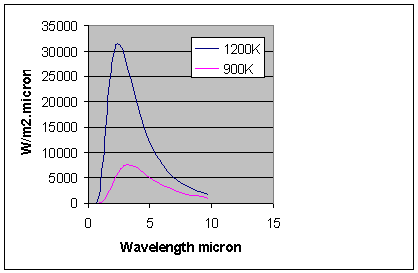-
What is Blackbody Radiation and how is it calculated?
Date posted:
-
-
Post Author
dev@edge.studio
1. What is a black body?
A [GLOSS]blackbody[/GLOSS] is a perfect absorber of incident radiation. Whatever the wavelength of incident radiation, no thermal radiation is reflected from the surface of a black body. A blackbody also emits the maximum energy possible for any given temperature.
Only a few substances such as carbon black approach the properties of a blackbody. Most surfaces, even many that appear black, are not perfect absorbers or emitters of thermal radiation.
2. How much radiation is emitted from a black body?
The energy emitted from a blackbody surface varies with wavelength. As the body gets hotter, more energy is emitted at shorter wavelengths. Above about
600°C, there is sufficient energy emission within the visible waveband of the spectrum (0.38-0.76
mm) for the surface to appear red. Planck first derived the relationship between energy emission and wavelength in 1900 from quantum atomic theory. The monochromatic [GLOSS]emissive power[/GLOSS] of a black surface (Eb,l)
at temperature
T(°Kelvin) is given by:
![]()
where
c1 = 3.74×108 Wmm4m-2
c2 = 1.4388×104
mm.K
and l is in micron
(mm) and Eb,l is in
Wm-2mm-1
The [GLOSS]spectral emission[/GLOSS] from a black body is plotted in Figure 1 for two temperatures. For a body between 500 and
1500°C more than 98% of the radiant energy falls in the industrially useful near infra-red waveband
(0.76-25mm). The wavelength corresponding to the peak radiant flux is inversely proportional to temperature T(K) and is given by Wien’s displacement law:
![]()

Figure 1. Radiant flux from a black body as a function of wavelength.
3. The Stefan-Boltzmann equation
Integration of the Planck equation over all wavelengths leads to the well known Stefan Boltzmann equation for [GLOSS]total radiation[/GLOSS] exchange from a black body surface:
![]()
where,
s
= the Stefan Boltzmann constant = 5.6687×10-8 Wm-2K-4
Eb is the total energy emission per unit area over all wavelengths from a point on a black surface to all directions in the hemisphere above it (i.e. into
2p[GLOSS]steradians[/GLOSS] of solid angle)
4. An example
The outside surface of a furnace wall is at 120°C. What is the rate of heat loss from the surface assuming it approximates to a black body? Be careful first to convert temperature to degrees Kelvin ( T(K) =
T(°C)+273.0)
Eb = 5.6687×10-8 x (120+273)4 = 1352W/m2
Sources
Thermal Radiation Heat Transfer, Robert Siegel & John R.Howell, 3rd Edition,
1992, Hemisphere, ISBN 0891162712
